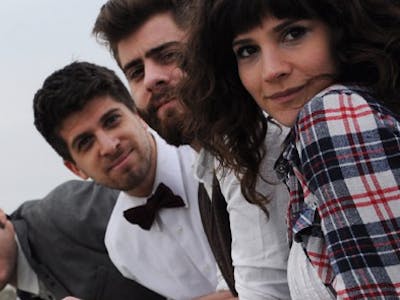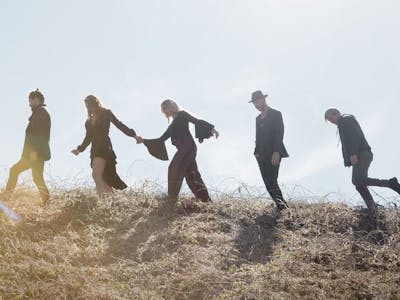Seymour Stein’s office sits way up in the highrises of the Rockefeller Plaza; a corner office, with a beautiful view out over New York City, its surfaces cluttered with all of the memorabilia, awards and accumulated paraphernalia of a lifetime spent in the music industry.
It was into this office that the six members of Delta Rae shuffled one day in the summer of 2011. A rather convoluted connection had led them here to this meeting, their first with a major record label, and no one was quite sure how to proceed. “We were very nervous,” recalls Ian Holljes, with perhaps some understatement.
“But we talked briefly, and then Seymour said ‘Well, why don’t you sing something for me?’” The band duly launched into Hey Hey Hey, a joyous, rollicking tune that begins with an exquisite four-part harmony. Ten seconds in, Stein asked them to stop. The band balked. But Stein stood up, walked to the door and hollered for his colleagues to join them. “You gotta hear these people!” he cried into the hallway. “They sound so beautiful!”
The story that led Delta Rae to Stein’s office, a major label deal, and the release of their stunning debut album, had in fact begun many years before, in the Holljes household, where siblings Ian, Eric and Brittany, enjoyed a childhood that was close yet itinerant, carrying them from Durham, North Carolina, to the Bay area of San Francisco, via Nashville, Tennessee, and Marietta, Georgia. Throughout it all, they relished the continuity of great music — their parents’ record collection, rich with James Taylor, Cat Stevens, Fleetwood Mac, Paul Simon.
Along the way, Ian and Eric forged what they describe as “a close musical bond” writing songs together from a young age. Their younger sister, meanwhile, was in possession of “this huge, brassy voice,” Ian recalls. “When she was young, it was like a lion that you couldn’t quite tame. But as she got older and we got to know her voice we saw the power in it.”
The brothers both headed back to Durham for college, and after graduation decided they should pursue music in earnest. They convinced their lion-voiced sister to join them, as well as an old friend, Elizabeth Hopkins, whose singing they had always loved — “it’s got that raspiness,” Eric says, “that old soul to it.”
The four set up home in an old house in the woods, and set about finding their collective voice, crafting their songs, and playing them live. “Very early on I felt we had found something special,” says Ian, who with his brother writes the lyrics. “It was really the uniting of the four voices, a type of music that resonated with me. Just to be in the thick of it is amazing, because the four people in this band sing with such heart — you just lose yourself in it.”
By late 2010, the four had become six, with the addition of drummer Mike McKee and bassist Grant Emerson, and were honing their material on the road. A lot of the songs evolved through live performance: Mike, for instance, innovating the percussion with chains and trash can lids, while Grant picked up an upright bass to round out the band’s sound.
For Ian, Eric, Brittany and Elizabeth it was a matter of working out how best to get their voices, their words, and their sentiment heard. “Playing those early shows, you’re often confronted by half-working sound-systems and weird venues and so you have to find an energy that can at times transcend the music,” Ian explains. “So a lot of times we’d come down off stage and sing something in the middle of the audience, or be screaming out as opposed to singing in order to convey the emotion, to find something primal that will affect people.” Soon earning a reputation as incredible live performers, the band's hope was that if their music was pushed and pulled and tried and tested in front of an audience, then by the time they came to record, the songs would be strong and robust.
The 12 songs on Carry the Fire display that muscularity, as well as great tenderness and, at times, vulnerability. They are songs that reflect the great stew of the band’s own shared histories and influences, as well as those of the land that bore them. There is the richness of Americana, of gospel, bluegrass, blues and pop, but there is also the well-oaked, deep-rooted tradition of storytelling, folklore, mythology. There is a thread that binds together west coast harmonies and the gospel choir, Southern gothic and civil rights, all of the tensions and the joys and the fierce, bright hope of America’s great cultural, geographical, musical journey.
Some of the songs here explore their relationship with Durham — the city where they now live of course, but also where the Holljes’ mother was raised, and where their parents studied. “The song Surrounded is about how the town has a lot of ghosts for us,” Ian explains. “It’s about the relationships that we make and the people that we fall in love with and the ghosts of the people that they’ve been with before and who have left an impression on them.”
Country House, too, stems from Durham: charting the year Ian spent caring for his former professor, a paraplegic; a time that gave him cause to contemplate the isolation of growing older, and the mortality of those we love. And the stirring, bittersweet Holding On to Good belongs here too, nodding to Brittany’s decision to leave behind her first love and move to North Carolina to make music.
As well as tales of loves lost and kindled and preserved, there are plenty of songs on the album shaped by the shared history of the siblings (and Elizabeth, a friend since childhood) and that celebrate the intensity of that bond.
Morning Comes, for instance, Ian describes as “coming very much from our family” of the strength they showed weathering hard times and unemployment, pressed on by “the feeling that the best moments come on the other side of that; if you can just hold out, then things get better.” Eric agrees: “I think a lot of our songs are laced with hope,” he says. “Even the darker ones have hopeful qualities to them. And I think that’s something we grew up with and we believe in — we believe in the resilience of people, and we’ve seen it time and time again.”
And certainly new single Is There Anyone Out There, carries this same spirit. A song that Ian wrote while working at a desk job, grafting 40 hour weeks, wondering if there might be more to life out there. “It’s a song about disillusionment,” he says, “about growing up and not necessarily being the person you envisaged yourself to be.”
It is this song, too, that has borne the album’s title. “It’s saying that we’re just moving forward, and we don’t have control over what the next generation does or what they do with what we give them,” Ian says. “We only get so long on earth, so all we can do is carry the fire.”
It is an appropriate image, perhaps, for this band — the inheritors of a great musical mantle, carrying forth such tradition, but bringing to it their own flame and ignition, the wisdom of their own generation, and the promise of so much to come.





